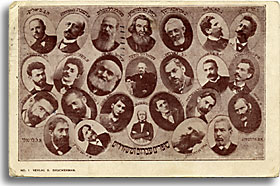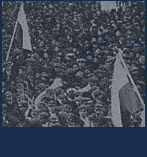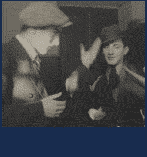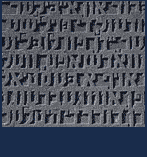

External Multilingualism.
We mentioned earlier that most Yiddish speakers were cognizant of the compound nature of the language because of their constant exposure to other languages in daily life. For most Jews, knowledge of other languages was oral in nature and varied widely in scope. A Yiddish speaker living in 19th-century Warsaw might have known enough Polish to conduct business with his neighbors, a little German to communicate at the Leipzig Fair, and some Russian, the language of the state, to communicate with officials. For the most part, Jews functioned in the external world as an economic bridge among different peoples.Thus their knowledge of languages other than their own native Yiddish was necessary to make this possible. Educated Yiddish speakers often were multilingual to a far greater extent- they could read difficult texts in other languages. Elye Bokher (1469-1549), known to his Christian contemporaries as Elia Levita, was born in Germany and active in Italy. As a scholar and teacher he taught Hebrew to a Catholic Cardinal in Rome. Consider his language expertise: he wrote a Hebrew grammar book, composed a Latin-German-Hebrew-Yiddish dictionary, and wrote poetry in Yiddish, most famously an epic poem entitled Bove-bukh, modeled after Italian sources!
True, Yiddish, like any language, also acted as a kind of social barrier shutting out the cultural assimilation that often occurs in the wake of linguistic assimilation. In place of a cultural life grounded in these external languages, Jews created a rich and variegated Yiddish culture all of their own. At the same time, Jews' continuing openness to languages other than their own allowed Yiddish language and culture to flourish. In Eastern Europe perhaps the possession of a Jewish language in which they lived and in which their culture grew, gave Jews the confidence to be resilient in the face of other cultures, as well as receptive to some aspects of those other cultures.
Yiddish, a Jewish language.
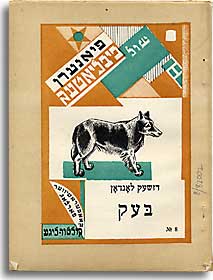

The awareness of the "hodge podge" composite nature of language attended the Jews when speaking any of the many Jewish languages, of which Yiddish was only one. Ladino, another popular Jewish language-with component parts mostly from Spanish and Hebrew-is written in Hebrew letters, as are all Jewish languages. Hebrew acted as a kind of cultural cement for the Jews and safeguarded their common history, religion, and religious practice. Throughout the many Jewish migrations and settlements during the Diaspora, the Jews put Hebrew (the language of Jewish prayer and study) in their "linguistic suitcase." leaving behind the vernacular language they spoke in a given place, only to replace it with another Jewish language once they were resettled in a different linguistic context. Some of the Jewish languages were only temporary necessities and not intended to generate a long-lasting culture. Ladino was different, and Yiddish was unique.
The History of Yiddish: Its Uniqueness as a Jewish Language
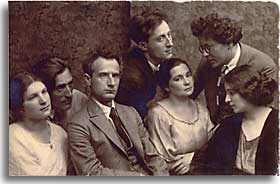

We can say that Yiddish was unique among Jewish languages in that it somehow jumped into the linguistic suitcase. According to Max Weinreich, founder of YIVO, Yiddish, like a number of European languages, emerged in cities on the banks of the Rhine in Germany around the year 1000 C. E. Jews from other parts of Europe settled there and slowly absorbed the vocabulary (words) and syntax (sentence structure) of their German-speaking neighbors. With time, the mixture of the language they spoke and the Germanic-language elements they had adopted, fused to create a new indigenous language, which was the basis of Yiddish. But Yiddish gained independence as a language when Yiddish speakers moved outside the German domain and continued to speak Yiddish. "Ashkenazi" Jews (Ashkenazi is the old Hebrew word for German), named for the place from which they originated, settled in Poland beginning in the 14th century and kept on adopting new linguistic elements without having shed the language they created in Germany.
The meeting of Yiddish with the Slavic linguistic world generated profound changes. These resulted in what one scholar described as a "Slavic culture with a German-based language living in a Hebrew library." So, although Yiddish vocabulary derives overwhelmingly from German, it adapted to its Slavic surroundings. How can we measure the changes that Yiddish underwent in the Jews' shift eastward to Poland? The Yiddish spoken by Polish Jews is markedly different from the Yiddish spoken by the Ashkenazi Jews who stayed in Germany and whose Yiddish is almost devoid of any Slavic element. In the Slavic context, Yiddish could not be perceived as simply another German dialect since it bore little resemblance to its neighboring languages. Why is it that Ashkenazi Jews always put Yiddish in their linguistic suitcase? The critical mass of their numbers and the autonomous nature of their social and cultural institutions guaranteed the independent life of Yiddish because it was firmly enmeshed in every aspect of Jewish life and culture.
What are the exact proportions of the component parts of the Yiddish language? A frequent estimate is that Yiddish is around 70% German, 20% Hebrew, and 10% Slavic. The large German component may be surprising even to Yiddish speakers. But what makes that language really Yiddish is the crucial role non-German components play in coloring its style and texture.

Throughout its existence, many have dismissed Yiddish as just another dialect of German, and an ugly one at that. This criticism raises the question, "What is a language?" To that, Max Weinreich famously answered, "...A language is a dialect with an army and a navy." History has shown that the endurance of a language, its continual growth, depends largely on whether it enjoys the status as an official language of a country and thus functions as the protected repository of its culture. With this in mind we may better appreciate the achievements of Yiddish language and culture. These emerged into the modern era in the mouths of a dispersed population forced to learn other languages in order to belong and survive. With neither a country nor a government to safeguard Yiddish-and lacking both "an army and a navy"-in the modern period alone, the Yiddish language nourished a world-class literature, spawned countless newspapers and journals, fed a flourishing theatre, and inspired the founding of ongoing institutions and political movements. From the early 19th century until the latter half of the 20th century, Yiddish secular culture competed in ambition and accomplishment with other European cultures. Let us now turn to some of these achievements.









